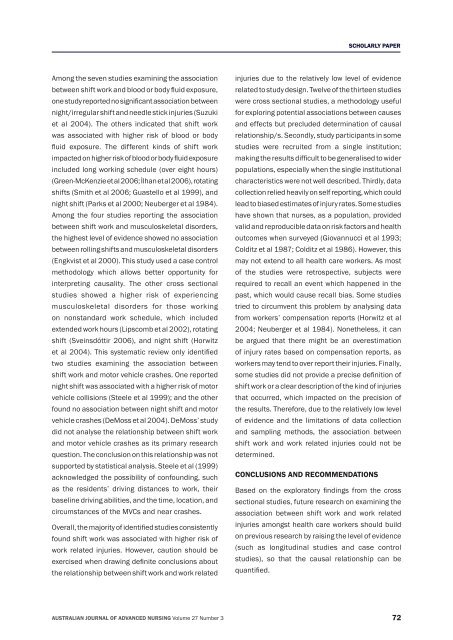March-May, 2010 - Australian Journal of Advanced Nursing
March-May, 2010 - Australian Journal of Advanced Nursing
March-May, 2010 - Australian Journal of Advanced Nursing
You also want an ePaper? Increase the reach of your titles
YUMPU automatically turns print PDFs into web optimized ePapers that Google loves.
Scholarly PAPER<br />
Among the seven studies examining the association<br />
between shift work and blood or body fluid exposure,<br />
one study reported no significant association between<br />
night/irregular shift and needle stick injuries (Suzuki<br />
et al 2004). The others indicated that shift work<br />
was associated with higher risk <strong>of</strong> blood or body<br />
fluid exposure. The different kinds <strong>of</strong> shift work<br />
impacted on higher risk <strong>of</strong> blood or body fluid exposure<br />
included long working schedule (over eight hours)<br />
(Green‐McKenzie et al 2006; İlhan et al 2006), rotating<br />
shifts (Smith et al 2006; Guastello et al 1999), and<br />
night shift (Parks et al 2000; Neuberger et al 1984).<br />
Among the four studies reporting the association<br />
between shift work and musculoskeletal disorders,<br />
the highest level <strong>of</strong> evidence showed no association<br />
between rolling shifts and musculoskeletal disorders<br />
(Engkvist et al 2000). This study used a case control<br />
methodology which allows better opportunity for<br />
interpreting causality. The other cross sectional<br />
studies showed a higher risk <strong>of</strong> experiencing<br />
musculoskeletal disorders for those working<br />
on nonstandard work schedule, which included<br />
extended work hours (Lipscomb et al 2002), rotating<br />
shift (Sveinsdóttir 2006), and night shift (Horwitz<br />
et al 2004). This systematic review only identified<br />
two studies examining the association between<br />
shift work and motor vehicle crashes. One reported<br />
night shift was associated with a higher risk <strong>of</strong> motor<br />
vehicle collisions (Steele et al 1999); and the other<br />
found no association between night shift and motor<br />
vehicle crashes (DeMoss et al 2004). DeMoss’ study<br />
did not analyse the relationship between shift work<br />
and motor vehicle crashes as its primary research<br />
question. The conclusion on this relationship was not<br />
supported by statistical analysis. Steele et al (1999)<br />
acknowledged the possibility <strong>of</strong> confounding, such<br />
as the residents’ driving distances to work, their<br />
baseline driving abilities, and the time, location, and<br />
circumstances <strong>of</strong> the MVCs and near crashes.<br />
Overall, the majority <strong>of</strong> identified studies consistently<br />
found shift work was associated with higher risk <strong>of</strong><br />
work related injuries. However, caution should be<br />
exercised when drawing definite conclusions about<br />
the relationship between shift work and work related<br />
injuries due to the relatively low level <strong>of</strong> evidence<br />
related to study design. Twelve <strong>of</strong> the thirteen studies<br />
were cross sectional studies, a methodology useful<br />
for exploring potential associations between causes<br />
and effects but precluded determination <strong>of</strong> causal<br />
relationship/s. Secondly, study participants in some<br />
studies were recruited from a single institution;<br />
making the results difficult to be generalised to wider<br />
populations, especially when the single institutional<br />
characteristics were not well described. Thirdly, data<br />
collection relied heavily on self reporting, which could<br />
lead to biased estimates <strong>of</strong> injury rates. Some studies<br />
have shown that nurses, as a population, provided<br />
valid and reproducible data on risk factors and health<br />
outcomes when surveyed (Giovannucci et al 1993;<br />
Colditz et al 1987; Colditz et al 1986). However, this<br />
may not extend to all health care workers. As most<br />
<strong>of</strong> the studies were retrospective, subjects were<br />
required to recall an event which happened in the<br />
past, which would cause recall bias. Some studies<br />
tried to circumvent this problem by analysing data<br />
from workers’ compensation reports (Horwitz et al<br />
2004; Neuberger et al 1984). Nonetheless, it can<br />
be argued that there might be an overestimation<br />
<strong>of</strong> injury rates based on compensation reports, as<br />
workers may tend to over report their injuries. Finally,<br />
some studies did not provide a precise definition <strong>of</strong><br />
shift work or a clear description <strong>of</strong> the kind <strong>of</strong> injuries<br />
that occurred, which impacted on the precision <strong>of</strong><br />
the results. Therefore, due to the relatively low level<br />
<strong>of</strong> evidence and the limitations <strong>of</strong> data collection<br />
and sampling methods, the association between<br />
shift work and work related injuries could not be<br />
determined.<br />
CONCLUSIONS and RECOMMENDATIONS<br />
Based on the exploratory findings from the cross<br />
sectional studies, future research on examining the<br />
association between shift work and work related<br />
injuries amongst health care workers should build<br />
on previous research by raising the level <strong>of</strong> evidence<br />
(such as longitudinal studies and case control<br />
studies), so that the causal relationship can be<br />
quantified.<br />
AUSTRALIAN JOURNAL OF ADVANCED NURSING Volume 27 Number 3 72

















